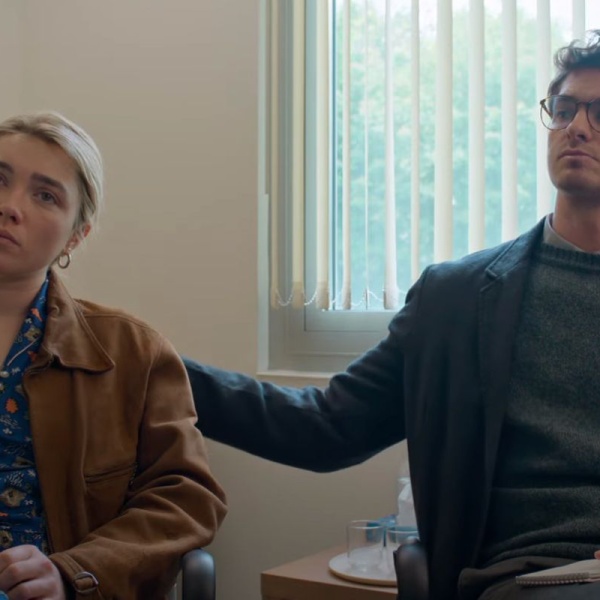
On Friday morning, writer-director James Cameron and producer Jon Landau hosted a screening of footage from the upcoming 3D rerelease of “Titanic,” Cameron’s 1997 Academy Award winner and box office record-setter. After screening 18 minutes or so of the film, which was painstakingly converted into 3D over a 60-week period, Cameron and Landau fielded questions from the audience and discussed the expansion of 3D into both the future and the past of the moviemaking industry.
Instead of showing full scenes, Cameron selected a sizzle reel of memorable moments from various scenes from the film, starting with the introduction of Rose as she boards Titanic, and concluding with the now-famous shot of the ship’s tail as Jack and Rose ride it down into the icy water below. Given the amount of time and effort devoted to the conversion, it’s no surprise that the sequences look terrific: in the iconic shot where Jack and Rose are perched on the mast, for example, the ocean opens up in front of them, and the new dimensionality offers an even more intoxicating sense of freedom and romance. In other scenes, such as Rose’s rescue of a handcuffed Jack, the hallways of the ship and the water that fills them creates a vivid sense of claustrophobia – and later, makes the farewells and resigned fates of various characters feel more poignant.
“I’m excited to bring ‘Titanic’ back to the big screen,” Cameron said in his introduction. “I always felt it was a much more powerful experience on the big screen than on video, and it really has to do with the psychology of going to the movie theater. We sort of make a pact with ourselves to commit two or three hours to the experience, and so the movie experience is actually becoming more important, because it’s the place where we decide, ‘this particular piece of entertainment, I want it for myself’.”
Cameron indicated that its familiarity with viewers might be its strongest selling point. “There are certain films that I think merit being brought back to the theater, because when you make that deal with yourself, it’s got to be something you’re reasonably certain you’re going to enjoy,” he observed. “And so, ‘Titanic’ is a film a lot of people have seen, obviously, sometimes multiple times, but there’s a whole generation of people who haven’t seen it in theaters at all. So the 3D is kind of a marketing hook, but I love the 3D – I think it looks spectacular. But it’s also just a way of kind of reinventing the concept of a re-release and getting people to come back in theaters and commit that three hours and 15 minutes to go through the experience again.”
Cameron joked about his own enthusiasm for 3D, which was hugely responsible for the explosion of 3D filmmaking industry-wide, but acknowledged that in spite of his preference for native 3D over conversion, there are a number of older titles that could and would benefit from being converted. “I’m very much kind of against conversion for films that had a choice,” he said. “But I do believe there are classic library titles – think of your ten or 20 favorite movies of all time – that should be converted. But it has to be done right. And by the time we’re finished we will have spent 60 weeks and about $18 million to do this.”
Despite the painstaking efforts of his team, he admits that the conversion will never quite be as perfect a 3D experience as if he’d originally shot the film using the technology. “It’s not perfect,” he said. “It’s 2.99D, it’s not really 3D. But most conversions are about 2.4D, so we just want to try to make that distinction.”
After the screening, Landau followed up with some more specifics about the process of preparing the film for re-release, and indicated that “Titanic” will be presented in multiple formats. “The first thing we did in this process is we created a digital master of the film, which didn’t exist, a 4K master. And when we come out in April, we won’t be exclusive to 3D screens. That will be the majority of our screens, but it will also be on 2D screens, and the 2D will be better prints than anything we could have done at the time.”
“It will look better than it’s ever looked before in 2D, Cameron added. “The 4K master is not a trivial process. Super-35 is a tiny bit grainy as a process, so we got rid of all of the grain and we sharpened up the edges, we did a full color correction and restoration process, so we started with an absolutely pristine master that was better than the film had ever been before. So even if you don’t like 3D and you want to watch the film in 2D, our 2D 35mm prints will look absolutely stunning – much better than they looked back in ’97.”
Cameron also indicated that the original film format used will create different viewing experiences for some audiences. “We shot the film in Super-35 and released it anamorphically, so it’s a widescreen format, but Super-35 gives you a little more height in the frame that you would normally see in theaters – you really only ever see it on video. So the extra height will be seen in IMAX theaters both in 3D and in 2D.” It should be noted that the differences are mostly nominal; Super-35 was used a lot in the 1990s when VHS releases were pan-and-scan, and the extra height allowed more of width of the original frame to be visible in a 4:3 format. Even in IMAX, the height of the frame will not be significantly longer, as is the case with films released more recently which featured IMAX photography.
As Cameron and Landau concluded the presentation, Landau clarified that the film that’s being released next April is not going to be different from any previous releases, except in that it’s remastered and in 3D. “We’re not changing the film,” he said. “The film that’s coming out is the film as it was released. That was the director’s cut.” Cameron said he doesn’t feel the need to change anything in the film, and confirmed he stands by the content of the original cut.
“I don’t have that revisionist gene, I guess. I don’t feel like there’s anything else I would do artistically to the film. So what we’re doing now with the conversion process is trying not to reinvent the film artistically but just show what the movie, frame-by-frame, what it would look like if we shot it in 3D at the time.”
“Titanic” is schedule for re-release nationwide on April 6, 2012.




